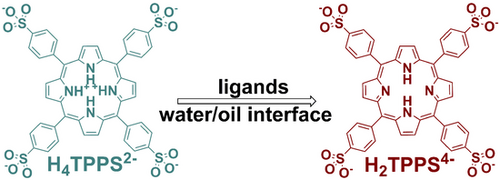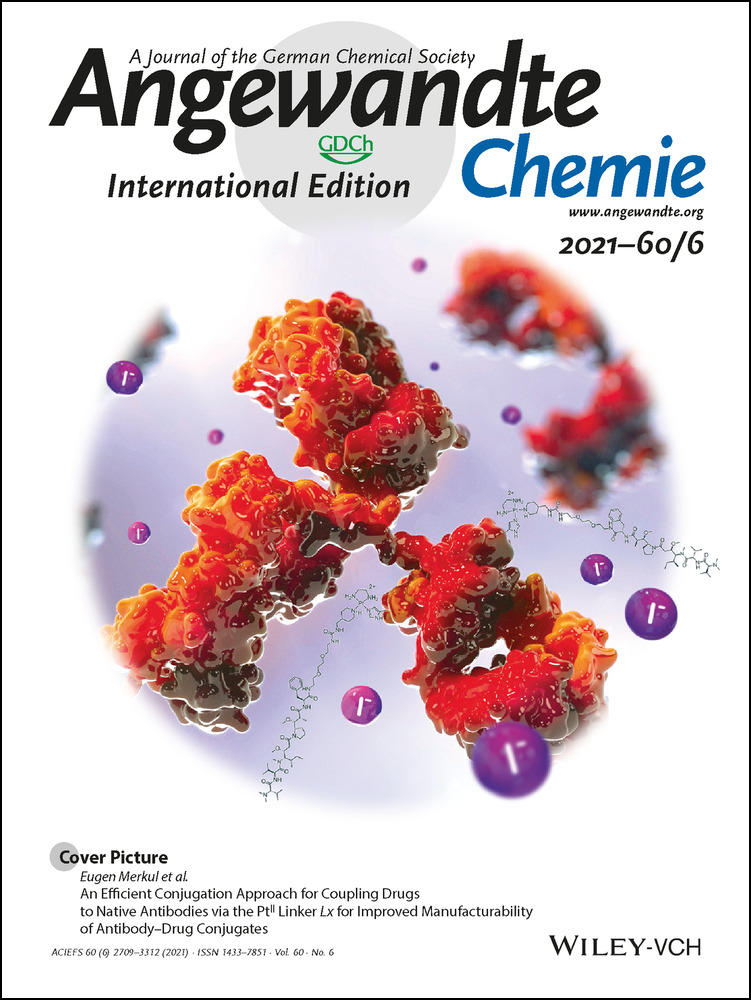Surfactant-Induced Interfacial Aggregation of Porphyrins for Structuring Color-Tunable Liquids
Dr. Pei-Yang Gu
College of Chemistry, Chemical Engineering and Materials Science, Collaborative Innovation, Center of Suzhou Nano Science and Technology, Soochow University, Suzhou, 215123 China
Materials Sciences Division, Lawrence Berkeley National Laboratory, 1 Cyclotron Road, Berkeley, CA, 94720 USA
Search for more papers by this authorDr. Ganhua Xie
Materials Sciences Division, Lawrence Berkeley National Laboratory, 1 Cyclotron Road, Berkeley, CA, 94720 USA
Search for more papers by this authorPaul Y. Kim
Materials Sciences Division, Lawrence Berkeley National Laboratory, 1 Cyclotron Road, Berkeley, CA, 94720 USA
Search for more papers by this authorDr. Yu Chai
Materials Sciences Division, Lawrence Berkeley National Laboratory, 1 Cyclotron Road, Berkeley, CA, 94720 USA
Molecular Foundry, Lawrence Berkeley National Laboratory, 1 Cyclotron Road, Berkeley, CA, 94720 USA
Search for more papers by this authorXuefei Wu
Materials Sciences Division, Lawrence Berkeley National Laboratory, 1 Cyclotron Road, Berkeley, CA, 94720 USA
Polymer Science and Engineering Department, University of Massachusetts, Amherst, MA, 01003 USA
Beijing Advanced Innovation Center for Soft Matter Science and Engineering, Beijing University of Chemical Technology, Beijing, 100029 China
Search for more papers by this authorYufeng Jiang
Materials Sciences Division, Lawrence Berkeley National Laboratory, 1 Cyclotron Road, Berkeley, CA, 94720 USA
Search for more papers by this authorProf. Qing-Feng Xu
College of Chemistry, Chemical Engineering and Materials Science, Collaborative Innovation, Center of Suzhou Nano Science and Technology, Soochow University, Suzhou, 215123 China
Search for more papers by this authorDr. Feng Liu
Department of Physics and Astronomy, Collaborative Innovation Center of IFSA (CICIFSA), Shanghai Jiaotong University, Shanghai, 200240 P. R. China
Search for more papers by this authorCorresponding Author
Prof. Jian-Mei Lu
College of Chemistry, Chemical Engineering and Materials Science, Collaborative Innovation, Center of Suzhou Nano Science and Technology, Soochow University, Suzhou, 215123 China
Search for more papers by this authorCorresponding Author
Prof. Thomas P. Russell
Materials Sciences Division, Lawrence Berkeley National Laboratory, 1 Cyclotron Road, Berkeley, CA, 94720 USA
Polymer Science and Engineering Department, University of Massachusetts, Amherst, MA, 01003 USA
Beijing Advanced Innovation Center for Soft Matter Science and Engineering, Beijing University of Chemical Technology, Beijing, 100029 China
Search for more papers by this authorDr. Pei-Yang Gu
College of Chemistry, Chemical Engineering and Materials Science, Collaborative Innovation, Center of Suzhou Nano Science and Technology, Soochow University, Suzhou, 215123 China
Materials Sciences Division, Lawrence Berkeley National Laboratory, 1 Cyclotron Road, Berkeley, CA, 94720 USA
Search for more papers by this authorDr. Ganhua Xie
Materials Sciences Division, Lawrence Berkeley National Laboratory, 1 Cyclotron Road, Berkeley, CA, 94720 USA
Search for more papers by this authorPaul Y. Kim
Materials Sciences Division, Lawrence Berkeley National Laboratory, 1 Cyclotron Road, Berkeley, CA, 94720 USA
Search for more papers by this authorDr. Yu Chai
Materials Sciences Division, Lawrence Berkeley National Laboratory, 1 Cyclotron Road, Berkeley, CA, 94720 USA
Molecular Foundry, Lawrence Berkeley National Laboratory, 1 Cyclotron Road, Berkeley, CA, 94720 USA
Search for more papers by this authorXuefei Wu
Materials Sciences Division, Lawrence Berkeley National Laboratory, 1 Cyclotron Road, Berkeley, CA, 94720 USA
Polymer Science and Engineering Department, University of Massachusetts, Amherst, MA, 01003 USA
Beijing Advanced Innovation Center for Soft Matter Science and Engineering, Beijing University of Chemical Technology, Beijing, 100029 China
Search for more papers by this authorYufeng Jiang
Materials Sciences Division, Lawrence Berkeley National Laboratory, 1 Cyclotron Road, Berkeley, CA, 94720 USA
Search for more papers by this authorProf. Qing-Feng Xu
College of Chemistry, Chemical Engineering and Materials Science, Collaborative Innovation, Center of Suzhou Nano Science and Technology, Soochow University, Suzhou, 215123 China
Search for more papers by this authorDr. Feng Liu
Department of Physics and Astronomy, Collaborative Innovation Center of IFSA (CICIFSA), Shanghai Jiaotong University, Shanghai, 200240 P. R. China
Search for more papers by this authorCorresponding Author
Prof. Jian-Mei Lu
College of Chemistry, Chemical Engineering and Materials Science, Collaborative Innovation, Center of Suzhou Nano Science and Technology, Soochow University, Suzhou, 215123 China
Search for more papers by this authorCorresponding Author
Prof. Thomas P. Russell
Materials Sciences Division, Lawrence Berkeley National Laboratory, 1 Cyclotron Road, Berkeley, CA, 94720 USA
Polymer Science and Engineering Department, University of Massachusetts, Amherst, MA, 01003 USA
Beijing Advanced Innovation Center for Soft Matter Science and Engineering, Beijing University of Chemical Technology, Beijing, 100029 China
Search for more papers by this authorGraphical Abstract
Abstract
Locking nonequilibrium shapes of liquids into targeted architectures by interfacial jamming of nanoparticles is an emerging area in material science. 5,10,15,20-tetrakis(4-sulfonatophenyl) porphyrin (H6TPPS) shows three different aggregation states that present an absorption imaging platform to monitor the assembly and jamming of supramolecular polymer surfactants (SPSs) at the liquid/liquid interface. The interfacial interconversion of H6TPPS, specifically H4TPPS2− dissolved in water, from J- to an H-aggregation was induced by strong electrostatic interactions with amine-terminated polystyrene dissolved in toluene at the water/toluene interface. This resulted in color-tunable liquids due to interfacial jamming of the SPSs formed between H4TPPS2− and amine-terminated polystyrene. However, the formed SPSs cannot lock in nonequilibrium shapes of liquids. In addition, a self-wrinkling behavior was observed when amphiphilic triblock copolymers of PS-block-poly(2-vinylpyridine)-block-poly(ethylene oxide) were used to interact with H4TPPS2−. Subsequently, the SPSs formed can lock in nonequilibrium shapes of liquids.
Supporting Information
As a service to our authors and readers, this journal provides supporting information supplied by the authors. Such materials are peer reviewed and may be re-organized for online delivery, but are not copy-edited or typeset. Technical support issues arising from supporting information (other than missing files) should be addressed to the authors.
| Filename | Description |
|---|---|
| anie202012742-sup-0001-misc_information.pdf2.9 MB | Supplementary |
Please note: The publisher is not responsible for the content or functionality of any supporting information supplied by the authors. Any queries (other than missing content) should be directed to the corresponding author for the article.
References
- 1B. Huang, W. C. Chen, Z. Li, J. Zhang, W. Zhao, Y. Feng, B. Z. Tang, C. S. Lee, Angew. Chem. Int. Ed. 2018, 57, 12473–12477; Angew. Chem. 2018, 130, 12653–12657.
- 2C. Shahar, S. Dutta, H. Weissman, L. J. Shimon, H. Ott, B. Rybtchinski, Angew. Chem. Int. Ed. 2016, 55, 179–182; Angew. Chem. 2016, 128, 187–190.
- 3R. V. Kazantsev, A. Dannenhoffer, T. Aytun, B. Harutyunyan, D. J. Fairfield, M. J. Bedzyk, S. I. Stupp, Chem 2018, 4, 1596–1608.
- 4X. Jia, C. Shao, X. Bai, Q. Zhou, B. Wu, L. Wang, B. Yue, H. Zhu, L. Zhu, Proc. Natl. Acad. Sci. USA 2019, 116, 4816–4821.
- 5S. Kundu, A. Patra, Chem. Rev. 2017, 117, 712–757.
- 6K. Liu, C. Yuan, Q. Zou, Z. Xie, X. Yan, Angew. Chem. Int. Ed. 2017, 56, 7876–7880; Angew. Chem. 2017, 129, 7984–7988.
- 7H. Jiang, L. Zhang, J. Chen, M. Liu, ACS Nano 2017, 11, 12453–12460.
- 8N. Zhang, L. Wang, H. Wang, R. Cao, J. Wang, F. Bai, H. Fan, Nano Lett. 2018, 18, 560–566.
- 9J. M. Ribó, J. Crusats, J.-A. Farrera, M. L. Valero, Chem. Commun. 1994, 681–682.
- 10L. Zhao, R. Ma, J. Li, Y. Li, Y. An, L. Shi, Biomacromolecules 2008, 9, 2601–2608.
- 11M. A. Castriciano, A. Carbone, A. Saccà, M. G. Donato, N. Micali, A. Romeo, G. De Luca, L. M. Scolaro, J. Mater. Chem. 2010, 20, 2882.
- 12G. De Luca, A. Romeo, V. Villari, N. Micali, I. Foltran, E. Foresti, I. G. Lesci, N. Roveri, T. Zuccheri, L. M. Scolaro, J. Am. Chem. Soc. 2009, 131, 6920–6921.
- 13N. C. Maiti, M. Ravikanth, S. Mazumdar, N. Periasamy, J. Phys. Chem. 1995, 99, 17192–17197.
- 14Y. Egawa, R. Hayashida, J.-i. Anzai, Langmuir 2007, 23, 13146–13150.
- 15P. Y. Gu, Y. Chai, H. Hou, G. Xie, Y. Jiang, Q. F. Xu, F. Liu, P. D. Ashby, J. M. Lu, T. P. Russell, Angew. Chem. Int. Ed. 2019, 58, 12112–12116; Angew. Chem. 2019, 131, 12240–12244.
- 16V. E. Blair, K. Celebi, K. Müllen, J. Vermant, Adv. Mater. Interfaces 2019, 6, 1801570.
- 17Z. Niroobakhsh, J. A. LaNasa, A. Belmonte, R. J. Hickey, Phys. Rev. Lett. 2019, 122, 178003.
- 18R. M. Clark, K. J. Berean, B. J. Carey, N. Pillai, T. Daeneke, I. S. Cole, K. Latham, K. Kalantar-zadeh, J. Mater. Chem. C 2017, 5, 6937–6944.
- 19Y. Zheng, Z. Yu, R. M. Parker, Y. Wu, C. Abell, O. A. Scherman, Nat. Commun. 2014, 5, 5772.
- 20G. Luo, Y. Yu, Y. Yuan, X. Chen, Z. Liu, T. Kong, Adv. Mater. 2019, 31, 1904631.
- 21B. Qin, S. Zhang, Q. Song, Z. Huang, J. F. Xu, X. Zhang, Angew. Chem. Int. Ed. 2017, 56, 7639–7643; Angew. Chem. 2017, 129, 7747–7751.
- 22K. Piradashvili, E. M. Alexandrino, F. R. Wurm, K. Landfester, Chem. Rev. 2016, 116, 2141–2169.
- 23J. F. Neal, W. Zhao, A. J. Grooms, M. A. Smeltzer, B. M. Shook, A. H. Flood, H. C. Allen, J. Am. Chem. Soc. 2019, 141, 7876–7886.
- 24J. Forth, D. J. French, A. V. Gromov, S. King, S. Titmuss, K. M. Lord, M. J. Ridout, P. J. Wilde, P. S. Clegg, Langmuir 2015, 31, 9312–9324.
- 25A.-L. Fameau, F. Cousin, L. Navailles, F. Nallet, F. Boué, J.-P. Douliez, J. Phys. Chem. B 2011, 115, 9033–9039.
- 26Z. Yang, J. Wei, Y. I. Sobolev, B. A. Grzybowski, Nature 2018, 553, 313.
- 27Y. Chao, H. C. Shum, Chem. Soc. Rev. 2020, 49, 114–142.
- 28W. Dai, F. Shao, J. Szczerbinski, R. McCaffrey, R. Zenobi, Y. Jin, A. D. Schluter, W. Zhang, Angew. Chem. Int. Ed. 2016, 55, 213–217; Angew. Chem. 2016, 128, 221–225.
- 29Y. Zhong, B. Cheng, C. Park, A. Ray, S. Brown, F. Mujid, J.-U. Lee, H. Zhou, J. Suh, K.-H. Lee, Science 2019, 366, 1379–1384.
- 30M. Nagel, T. A. Tervoort, J. Vermant, Adv. Colloid Interface Sci. 2017, 247, 33–51.
- 31K. Liu, H. Qi, R. Dong, R. Shivhare, M. Addicoat, T. Zhang, H. Sahabudeen, T. Heine, S. Mannsfeld, U. Kaiser, Z. Zheng, X. Feng, Nat. Chem. 2019, 11, 994–1000.
- 32H. Sahabudeen, H. Qi, B. A. Glatz, D. Tranca, R. Dong, Y. Hou, T. Zhang, C. Kuttner, T. Lehnert, G. Seifert, U. Kaiser, A. Fery, Z. Zheng, X. Feng, Nat. Commun. 2016, 7, 13461.
- 33X. Liu, N. Kent, A. Ceballos, R. Streubel, Y. Jiang, Y. Chai, P. Y. Kim, J. Forth, F. Hellman, S. Shi, Science 2019, 365, 264–267.
- 34H. Q. Peng, X. Zheng, T. Han, R. T. K. Kwok, J. W. Y. Lam, X. Huang, B. Z. Tang, J. Am. Chem. Soc. 2017, 139, 10150–10156.
- 35X. L. Ni, S. Chen, Y. Yang, Z. Tao, J. Am. Chem. Soc. 2016, 138, 6177–6183.
- 36Y. Chen, Y. Zhang, D. Karnaushenko, L. Chen, J. Hao, F. Ding, O. G. Schmidt, Adv. Mater. 2017, 29, 1605165.
- 37J. H. Koo, S. Jeong, H. J. Shim, D. Son, J. Kim, D. C. Kim, S. Choi, J. I. Hong, D. H. Kim, ACS Nano 2017, 11, 10032–10041.
- 38E. R. Sauvé, C. M. Tonge, Z. M. Hudson, J. Am. Chem. Soc. 2019, 141, 16422–16431.
- 39J. Mei, N. L. Leung, R. T. Kwok, J. W. Lam, B. Z. Tang, Chem. Rev. 2015, 115, 11718–11940.
- 40Y. Huang, J. Xing, Q. Gong, L.-C. Chen, G. Liu, C. Yao, Z. Wang, H.-L. Zhang, Z. Chen, Q. Zhang, Nat. Commun. 2019, 10, 169–177.
- 41Y. Huang, Z. Wang, Z. Chen, Q. Zhang, Angew. Chem. Int. Ed. 2019, 58, 9696–9711; Angew. Chem. 2019, 131, 9798–9813.
- 42M. Cui, T. Emrick, T. P. Russell, Science 2013, 342, 460–463.
- 43J. Forth, P. Y. Kim, G. Xie, X. Liu, B. A. Helms, T. P. Russell, Adv. Mater. 2019, 31, 1806370.
- 44J. Forth, X. Liu, J. Hasnain, A. Toor, K. Miszta, S. Shi, P. L. Geissler, T. Emrick, B. A. Helms, T. P. Russell, Adv. Mater. 2018, 30, 1707603.





